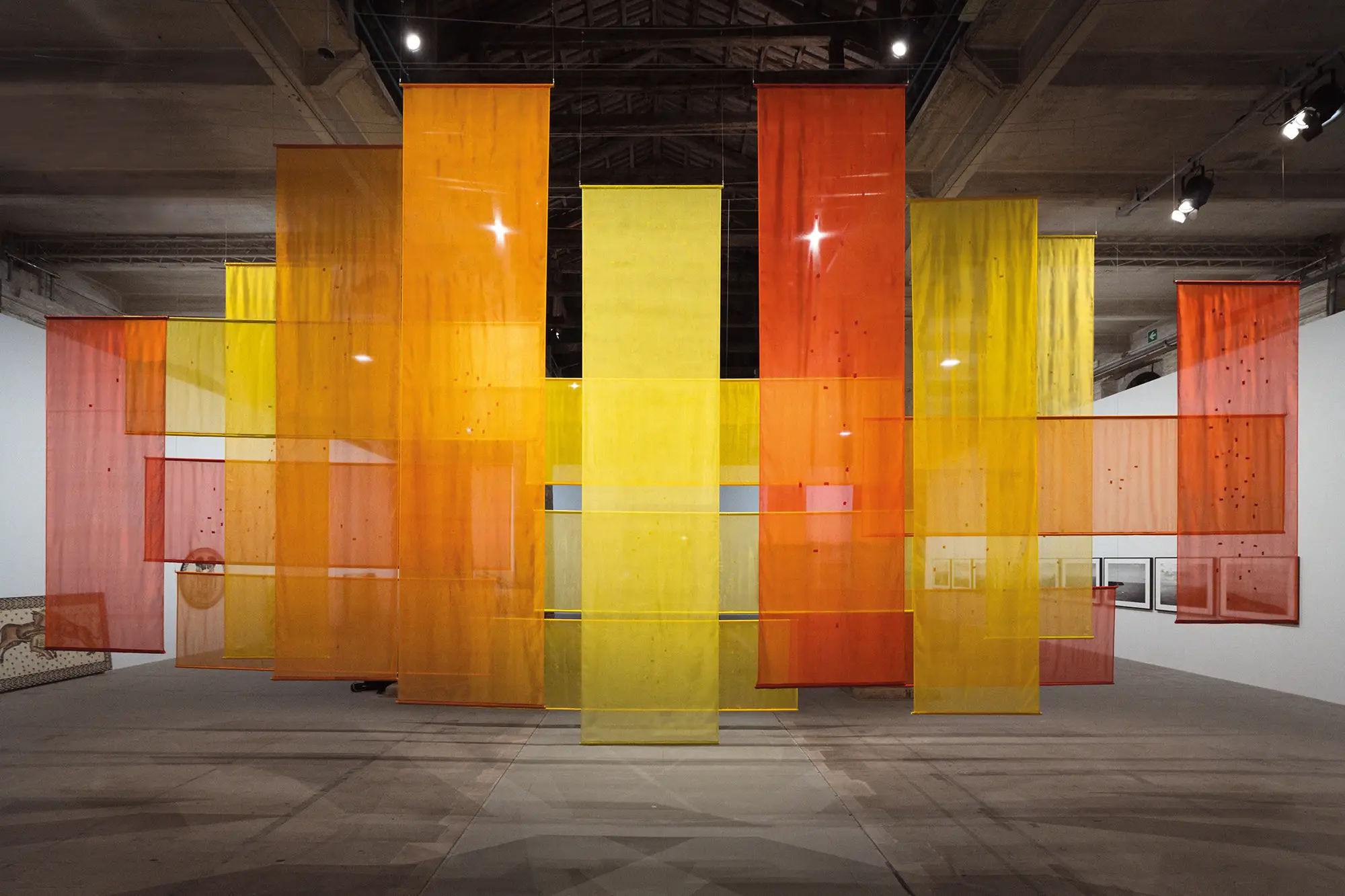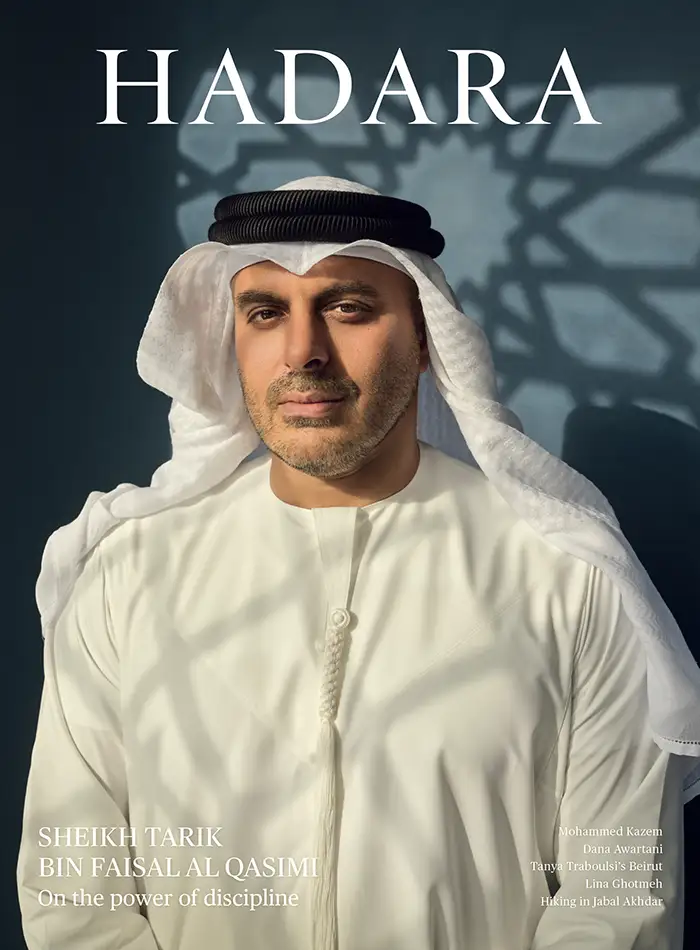All we can do is mend
Dana Awartani meditates on themes of cultural loss, the scars it leaves behind, and the power of healing.
By Anna Seaman
In the once densely populated northwestern quarter of Gaza City, Qasr Al Basha was erected in the 13th century as a fortress for a Mamluk sultan. Its limestone structure, geometric patterns, domes, and intersecting vaults endured for centuries. It bore witness to the rise and fall of the Ottoman Empire, once housed Napoleon Bonaparte during his military campaign to Egypt, and later served as a police station during World War I. Abandoned in 1967, the building was placed under UN protection in 1998 and opened as Gaza’s national museum in 2010. By the end of 2023, the palace had been severely damaged, resulting in the loss of thousands of historical artefacts.
When Dana Awartani took her ruler and compass to recreate the geometric patterns that once adorned the walls of Qasr Al Basha, it was more than an artistic gesture. It was an act of healing, of remembrance, and “a melancholic visual requiem”. This poignancy translates into the physical and visual aspects of the work. Comprising a floor installation of 730 handmade clay bricks, made using ancient construction techniques in collaboration with artisans in Saudi Arabia, and a series of ink and gouache study drawings, Standing by the Ruins II is, as with so many of Awartani’s works, quiet and beautiful yet powerfully engaging. The bricks, rendered in three earthy tones, slot together in perfect harmony, yet are cracked and delicate due to the artist’s deliberate omission of a binding agent. Their dual strength and fragility reflect the vulnerability of the original structure, its architecture, and its history.
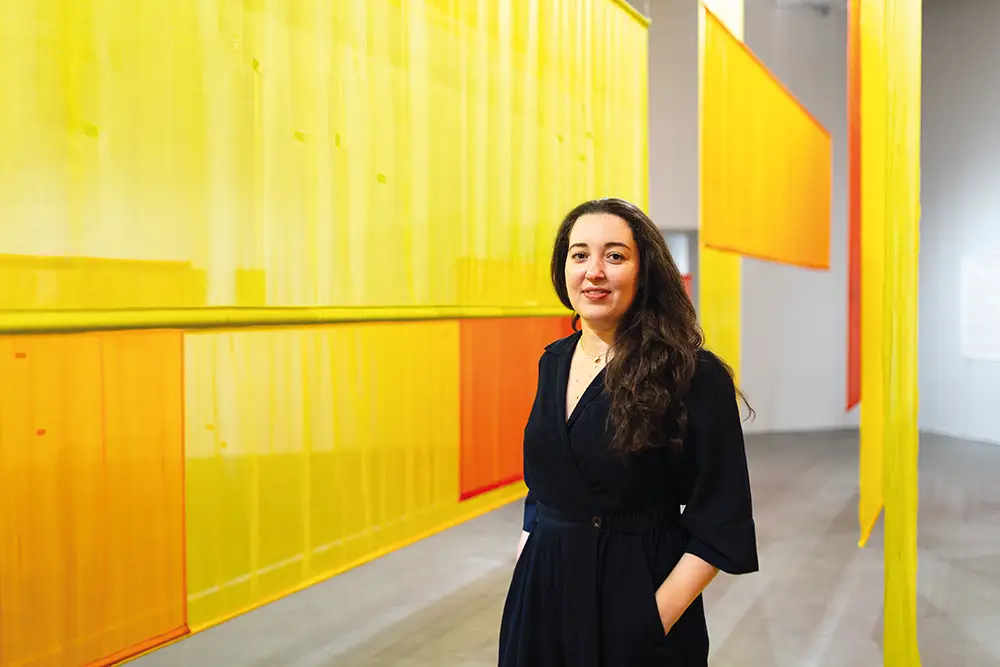
Opening image, Come, let me heal your wounds. Let me mend your broken bones (2024). In the face of ongoing cultural loss, the work is both a plea to safeguard ancient civilisation as well as a bid to rejoice in the collective history of artisanship. Above, Dana Awartani. Artwork courtesy of Venice Documentation Project. Awartani by Lisa Whiting Photography.
Sometimes, Awartani reflects, images of damaged cultural monuments attract more global attention than the human stories behind them. “A monument represents our collective history, and Gaza has such an old history shaped by so many religions and civilisations.” It is an act of remembrance then to talk about what is happening there through the lens of cultural loss.
Many of Awartani’s recent works respond to events in Gaza in this way. From June to September, Awartani staged her first European solo exhibition at Bristol’s Arnolfini contemporary arts centre. It featured pieces from Come, let me heal your wounds. Let me mend your broken bones, commissioned for the Venice Biennale in 2024, as well as a new floor commission that recreates geometric motifs from the now-destroyed Hamam al-Samara, a Mamluk-era public bathhouse that lay three metres below ground level in Gaza City’s Zeitoun quarter.
Awartani, of Palestinian, Jordanian, and Syrian heritage, was born and raised in Saudi Arabia. She studied fine art at Central Saint Martins in London, went on to do her master’s at The Prince’s School of Traditional Arts, and then trained in Turkey with a master in illumination to receive an ijazah. There is a reverence for traditional craft across her practice and the aesthetics of sacred geometry play a role in most of her works. However, rather than spiritual or philosophical, geometry and aesthetics are a tool to address social and other issues. “I see my work as a way to respond to trauma,” she says. “It is also an act of healing. Amid all this [loss], all we can do is mend. The physical gestures in my practice, whether building and laying bricks, or stitching and darning, are acts of mending.”
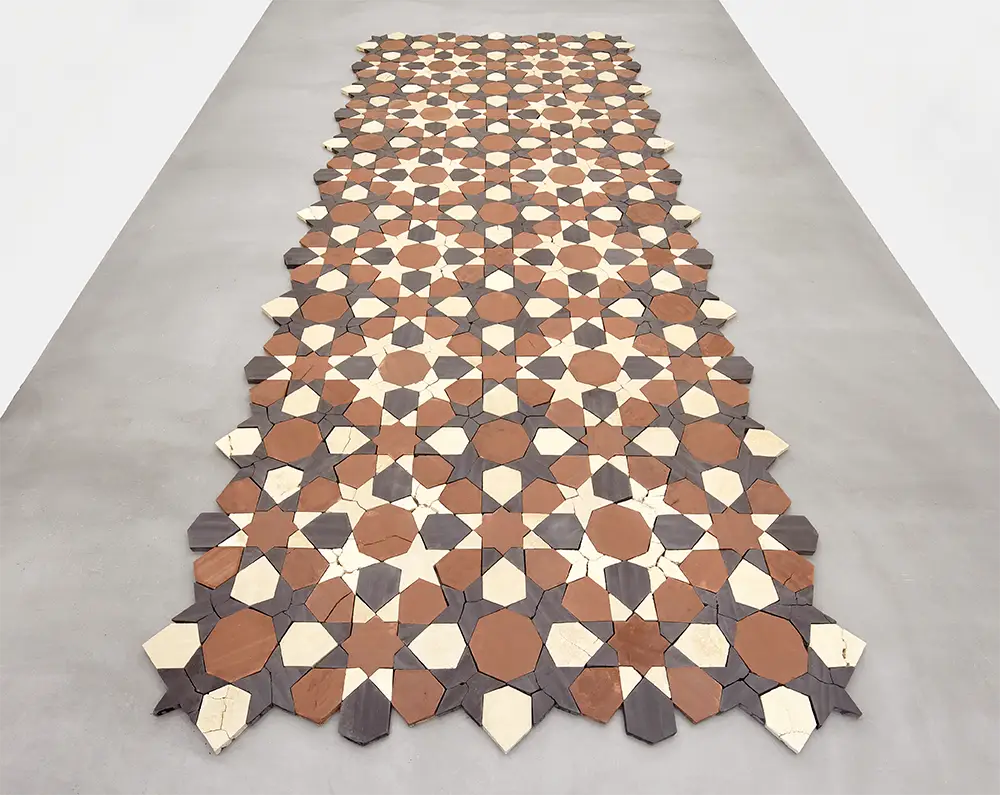
Standing by the Ruins II (2024).Courtesy of Sfeir-Semler Gallery.
That ethos of repair lies at the heart of Come, let me heal your wounds. Let me mend your broken bones, first shown in Venice. In this series, Awartani tore nearly 400 holes in yards of hand-dyed silk with each rip symbolising a heritage site in the Arab world that has been lost or damaged. Drawing on data compiled by the Antiquities Coalition, she catalogued sites in Palestine, Saudi Arabia, Syria, Tunisia, Libya, Iraq, Egypt, and Yemen and paired each one with an abstract representation on silk in shades of yellow, orange, green, and red. The punctures in the fabric were then stitched together by darning—a practice far more intimate than patchwork but no longer valued—quietly reassembling and, therefore, rebuilding. The scars reflect the emotional and physical wounds left behind in the real world.
The work not only places emphasis on lost monuments, but also on the slow disappearance of craftsmanship. The silk was handmade and dyed with natural pigments—many with medicinal properties—by skilled artisans in Kerala in southern India. “I am a craftswoman, and I am an artist,” Awartani says. “Craft doesn’t need to be extinct, and contemporary art doesn’t need to be confined only to the realms of concept. I find a middle ground between the two.”
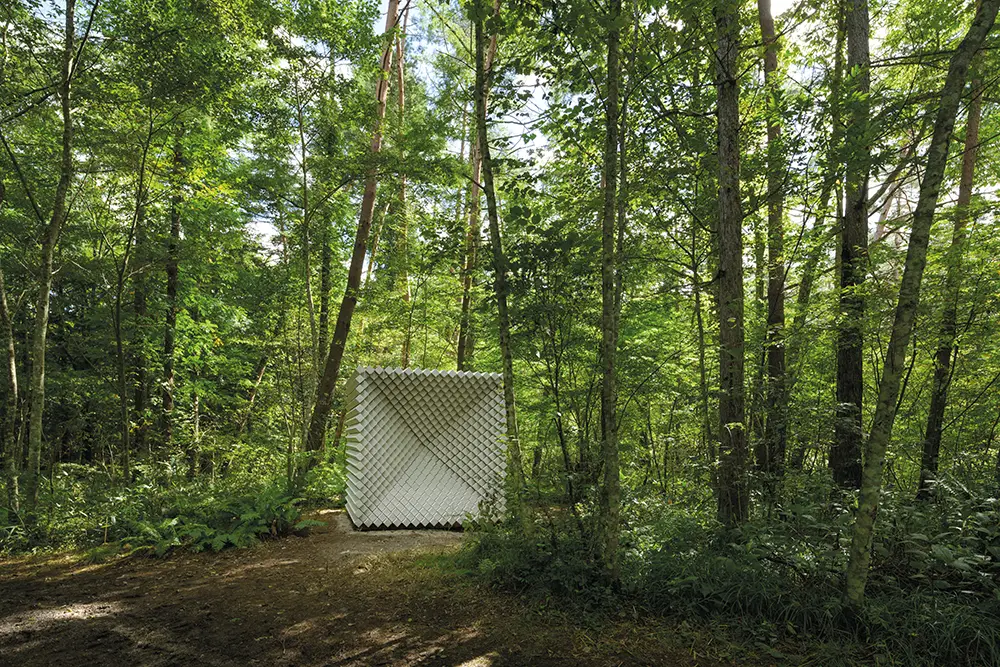
When Our Paths Collide (2024). This sculpture, in Omachi City, Japan, was inspired by the history of the salt trade. Salt was harvested from the shores of the Sea of Japan and transported inland. These routes were known as Salt Roads. Made from locally sourced materials, the cubic shape of the artwork echoes the geometry of salt crystals. Courtesy of the Artist and the Northern Alps Festival
Her 2022 work Where the Dwellers Lay, unveiled at Desert X AlUla, employed the language of traditional crafts and architecture, reviving decorative skills lost to time or rendered obsolete by technological innovation. The work, a concave geometric sculpture, was inspired by the region’s Nabataean tombs and their decorative facades. The 10-fold design echoed the stairwell patterns carved on the exterior of the tombs, and showcased Awartani’s expertise in Islamic geometry.
For Awartani, collaboration with artisans is fundamental. Her 2023 work When the Dust of Conflict Settles was created with a group of Syrian apprentice stonemasons participating in a World Monuments Fund training programme in Jordan, having left their home cities. The work—a series of hand carvings on griesa, jerashi, madaba, hoota and qassimi stone—was intended to bring awareness to the importance of traditional knowledge in reconstructing the future.

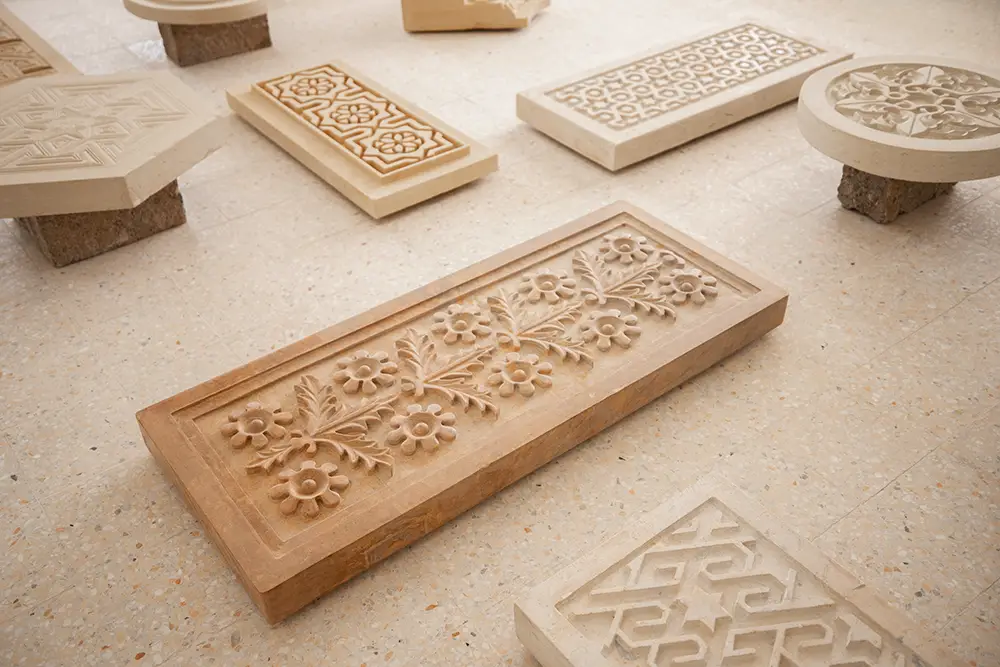
Top, Where the Dwellers Lay (2022). Shown at Desert X AlUla, a geometric sculpture references the Nabataean tombs at Hegra and their decorative facades. Above, When the Dust of Conflict Settles (2023) examines the repercussions of conflict on cultural heritage. Top, courtesy of the artist and Desert X AlUla; Above, courtesy of the artist.
“I use my funding to support these craftsmen and I continue relationships with people who help me,” she explains. “It is important to support the livelihoods of these master craftsmen. I find it problematic that machines have taken over so many sectors of our lives and that people are losing livelihoods as well as tradition.”
Her most recent commission debuts this month at the inaugural Bukhara Biennial, where 70 artists are exhibiting under the banner Recipes for Broken Hearts. Curated by Diana Campbell, the works celebrate the healing power of art, with a strong focus on craft and cultures of togetherness. For her floor-based installation, Awartani sourced clay from Palestine to be used in a collaboration with Uzbek ceramicists. “I resonate with Diana’s title because there are many solutions to be found in ancient knowledge and that is one of the reasons I work hard to preserve it,” she says. Ancient wisdom, Awartani suggests, may hold the keys to meeting today’s challenges and building a more hopeful tomorrow.


